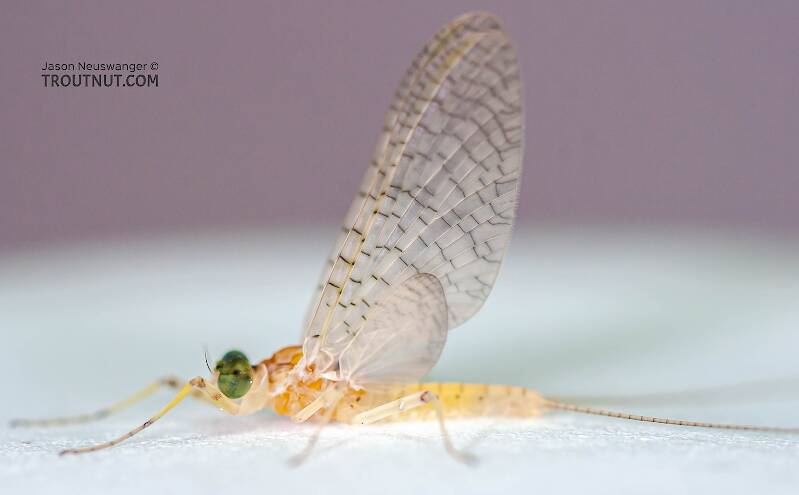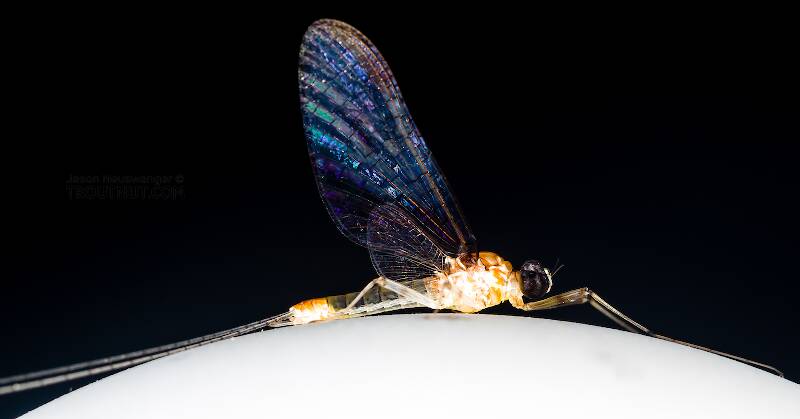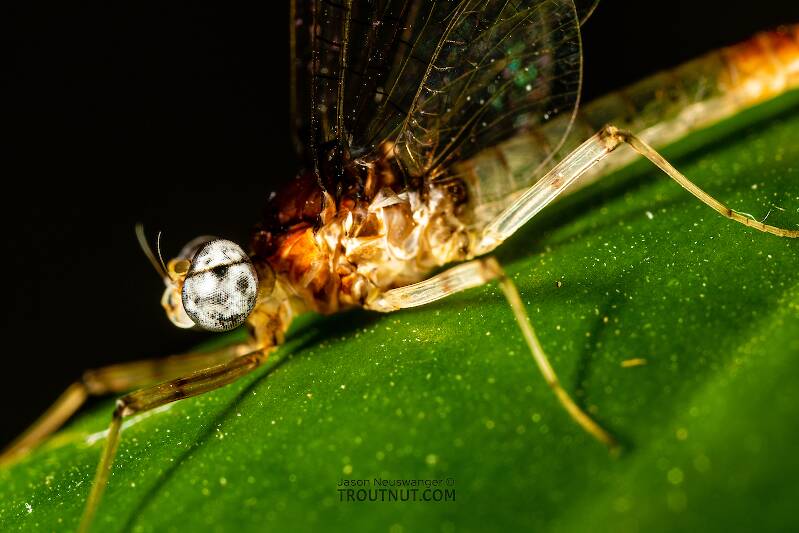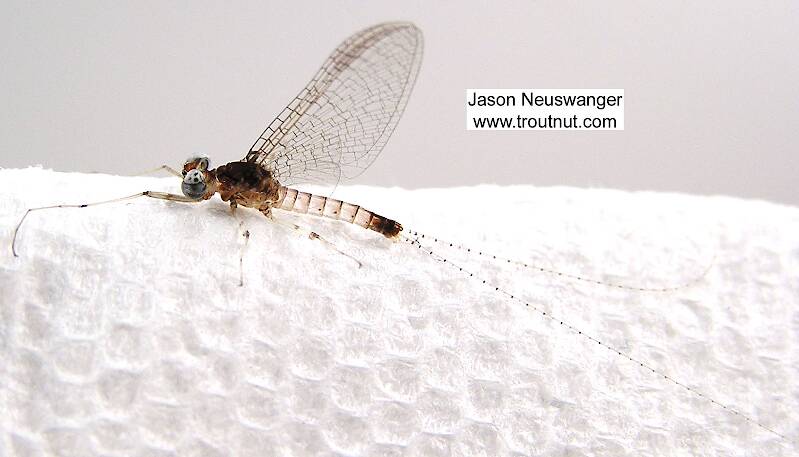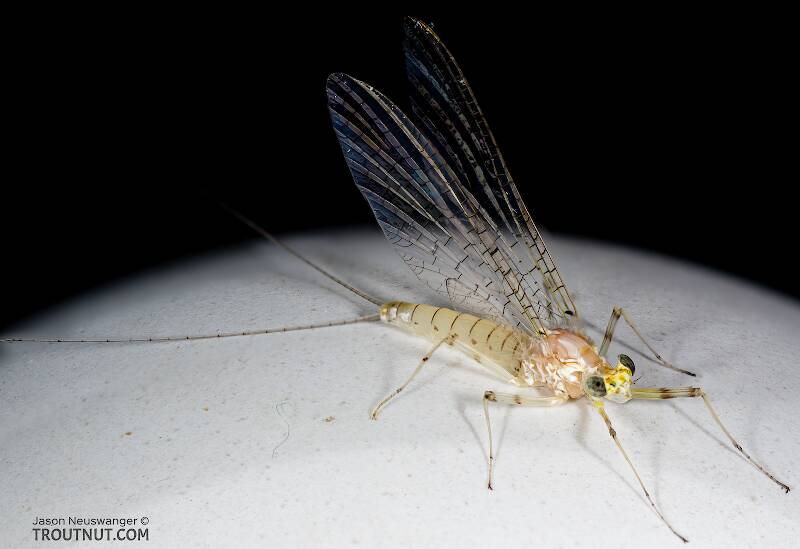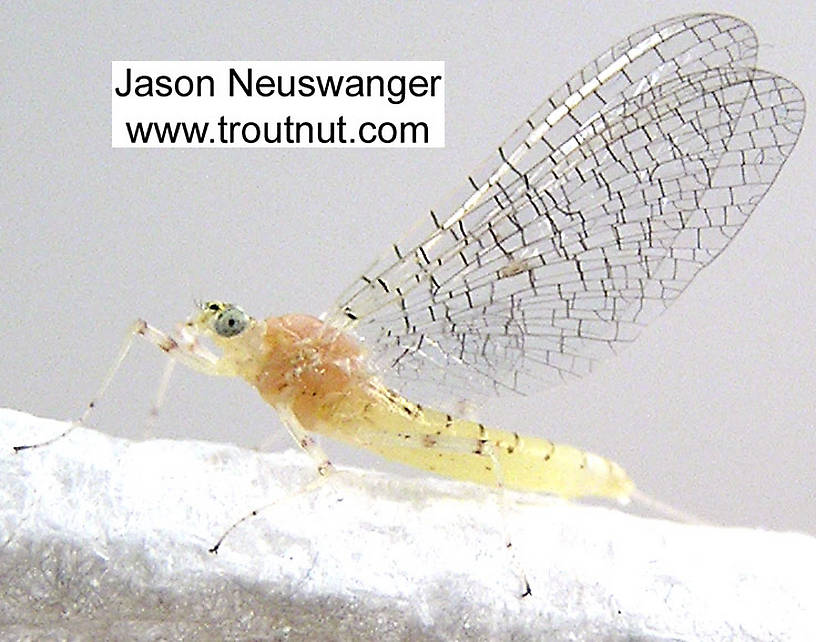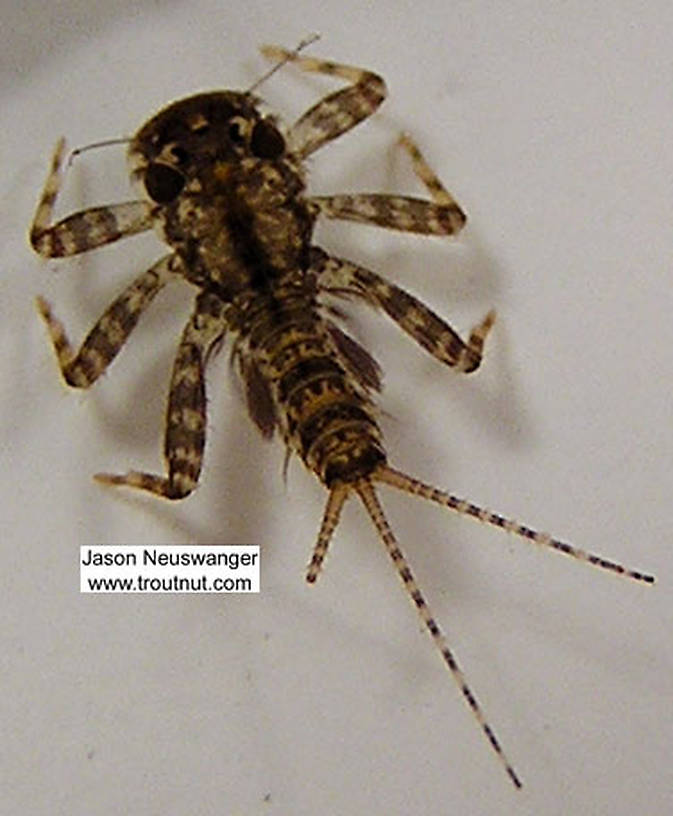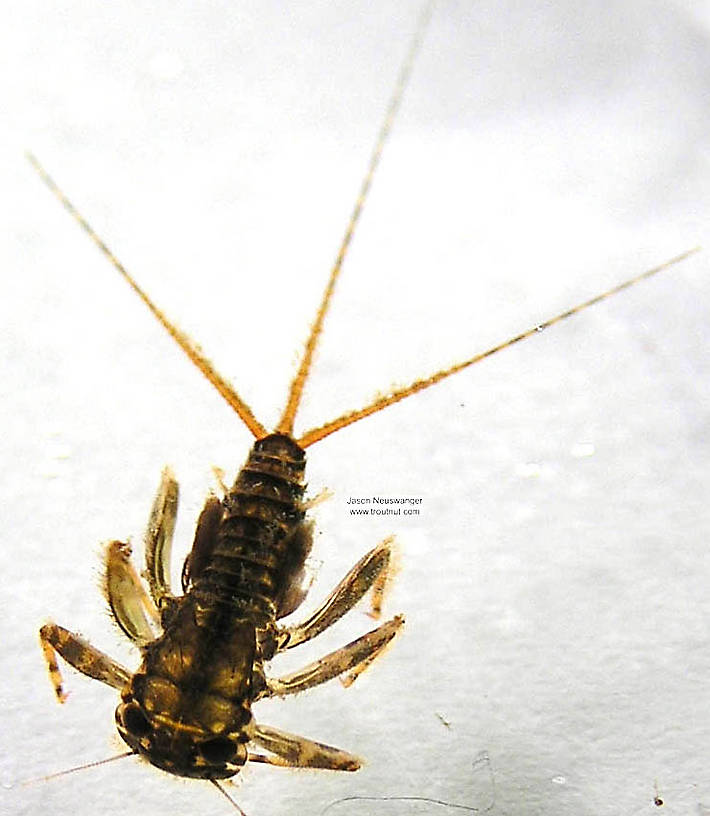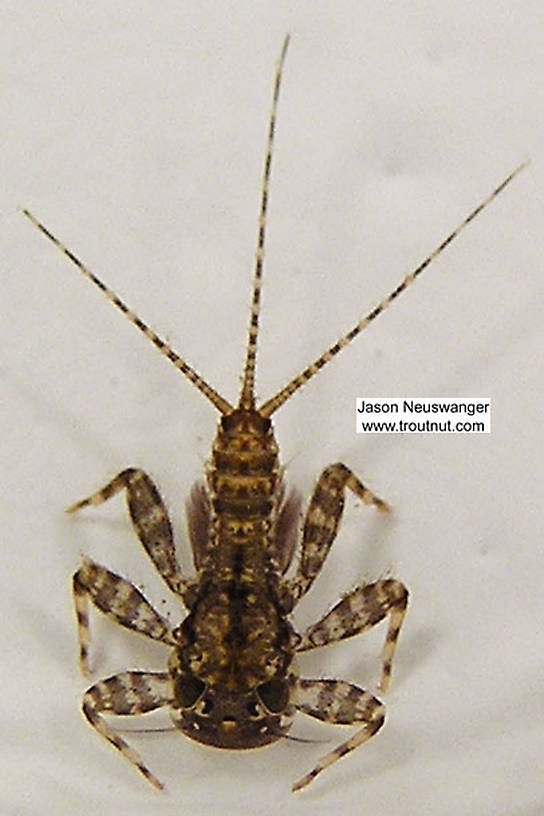
Blue-winged Olives
Baetis
Tiny Baetis mayflies are perhaps the most commonly encountered and imitated by anglers on all American trout streams due to their great abundance, widespread distribution, and trout-friendly emergence habits.


Mayfly Species Stenonema modestum (Cream Cahills)
Where & when
The Leonards in Mayflies of Michigan Trout Streams say that this species is veryabundant in parts of Michigan, and the same probably holds true elsewhere in its widespread range.
In 37 records from GBIF, adults of this species have mostly been collected during June (43%), July (38%), and August (8%).
Species Range
Physical description
Most physical descriptions on Troutnut are direct or slightly edited quotes from the original scientific sources describing or updating the species, although there may be errors in copying them to this website. Such descriptions aren't always definitive, because species often turn out to be more variable than the original describers observed. In some cases, only a single specimen was described! However, they are useful starting points.
Male Spinner
Wing length: 8-11 mm
A species of Stenonema pulchellum group, allied to S. rubromaculatum (now a synonym of Stenonema modestum); spiracular dots present; tails darker at joinings.
Head pale brownish to clay-colored; an indistinct narrow dark line across center of median carina; antennae faintly dusky; vertex dull purplish brown, often with a dark brown spot on each side. Thorax pale brownish to clay-colored, distinctly tinged with pale purplish or pinkish. Dark purplish brown median geminate line on pronotum, its anterior and posterior margins narrowly purplish black. Purple streak on pleura, extending down on base of fore leg. Ochreous markings on pleura. A wide paler median stripe on mesonotum, including scutellum; latter does not appear as distinctly whitish, however, as in some other allied species, but is tinged with pinkish. Posterior portion of metanotum, especially laterally, much darker than anterior, this dark area appearing as a brown band at base of paler abdomen. A brown area on pleura between bases of fore and middle legs; a wide oblique dark streak back of fore leg. Purplish black markings on fore coxa, on lateral margins; middle and hind coxae with similar black markings, and a dark spot above each; tinged with reddish brown. Sternum clay-colored; prosternum and median area of mesosternum tinged with brown. Fore femur dusky, distinctly yellow-tinged; median and apical purplish bands; tibia widely black at apex; tarsal joinings yellowish brown, claws dark brown at base. Basal joint of fore tarsus about 1/2 the length of the second. Middle and hind legs yellowish white; femora with median and apical bands; tibiae narrowly black at apices; tarsal joinings as in fore leg. Wings hyaline; longitudinal veins of costal margin yellow, others somewhat yellowish; cross veins dark reddish brown, heavier than longitudinals, humeral vein especially thickened; 5 to 6 cross veins in basal costal space, about 11 beyond bulla; 2 cross veins in costal space, at bulla; 2 or 3 below it, in subcosta. Stigmatic area with reddish stain in subcostal space, in most specimens. Veins of hind wing almost colorless.
Abdominal segments 1-6 and basal portion of 7 hyaline whitish; very narrow dark posterior margins on tergites, most evident in dorsal area, appearing as dark mid-dorsal dashes. Distinct dark stigmatic dots present on segments 2-8, quite faint on 2 and 8, prominent on 3-7. Segments 8 -10 opaque, also apical portion of 7; pale reddish yellow; posterior margins of tergites pale purplish brown, most evident on 10. Genitalia of rubromaculatum type, slightly less L-shaped than in S. rubromaculatum (see fig. 91). Tails white; at base, a few joinings pale, beyond this, alternate joinings narrowly purplish black.
Allied to rubromaculatum and S. nepotallum (now a synonym of Stenonema mediapunctatum). The purple-pink flush of the thorax seems distinctive; apical tergites more extensively marked than in former, femora more distinctly banded than in latter species.
Described as S. rubromaculatum
Body length 8 mm, wing length 8-10 mm
A member of Stenonema pulchellum group; stigmatic area with reddish stain; spiracular dots present; tails dark-banded.
Eyes pale pearly grey, in living insect. Frons and carina whitish; a faint brownish oblique streak on each side of carina, and minute dark dot at its base. Bases of antennae and a lateral streak next to eye on level with antenna rusty or tawny brown; antenna whitish. Vertex pale creamy; yellowish tinges around lateral ocelli and a light rusty or tawny brown spot behind median ocellus; two oblique tawny brown streaks extend backward from median line to eyes; posterior portion of head hyaline. Faint yellow-brown shading between eyes and lateral ocelli. Prothorax whitish; faint smoky shade on median area. Mesonotum light olive grey or pale clay; anteroIateral margins alabaster white; entire scutellum white, “lateral elevations and hollow behind the scutellum being tinged with pale sepia brown” (McD.). Pleura whitish; area anterior to base of middle leg tinged with brown; a black dot behind middle coxa, and brownish shading anterior to it. Anterior portion of metasternum, including median projection, alabaster white; posteriorly pale sepia brown; remainder of sternum whitish. Fore coxa tinged laterally with reddish brown; a fine black streak extends obliquely upward from this toward prothorax. Femur and tibia of fore leg subequal; very faintly amber-colored; femur with smoky shading and a median and apical purple-red band; tibia blackish at apex, which color extends over to base of tarsus. Tarsus pale; joinings and distal joint smoky; basal joint slightly less than half the length of second. Coxae and trochanters of middle and hind legs alabaster white, shaded with brown slightly at apex; bases of coxae with tawny brown shading, fainter on hind legs. Femora and tibiae very pale amber; faint median and apical femoral bands; femur slightly longer than tibia. Tarsi pale whitish; joinings and distal joint smoky. Wings hyaline; stigmatic area amber-tinged, a distinct purplish-red stain in subcostal space. Longitudinal veins deep smoky amber; cross veins blackish brown. Humeral cross vein heavily blackish; basal costal veins moderately fine and rather widely spaced, 3-5 of these. At bulla, 2 cross veins in costal space, 2 in subcosta, 3 below radius; 11-13 in costo-apical space. Cross veins very fine in anal area, in hind wings largely hyaline.
Abdominal segments 1-7 pale hyaline whitish; very narrow dark posterior margins on tergites in dorsal area; fine dark spiracular dots, 2-7. Segments 8-10 opaque alabaster white; tergites shaded with pinkish brown; only a narrow median pink streak on 8, no shading on posterior margin of 10. Forceps dull whitish; genitalia of rubromaculatum (now a synonym of Stenonema modestum) type (McDunnough's tripunctatum type (now a synonym of Stenonema femoratum)), distinctly L-shaped, the apical margin almost straight, and forming a right angle with vertical margin. Tails whitish; joinings narrowly blackish brown.
This species is very close to S. nepotellum (now a synonym of Stenonema mediapunctatum) and to annexum (now a synonym of Stenonema modestum) in the imago stage, although readily separable on nymphal characters. Imago may be distinguished from former species by the duller and paler thorax, the narrower dark posterior margins of tergites, and the more restricted pinkish shading on tergite 8. The thorax is also paler than in annexum, and tergites 8-10 less extensively marked than in that species. Color pattern on ventral surfaces of nymphs of these species is distinctive.
Described as S. rubrum
Body length 7 mm, wing length 8 mm
A rather small species of Stenonema pulchellum group; dark spiracular dots present; faint reddish tinge in stigmatic area of wing; tail joinings purple-brown.
Frontal portion of head pale whitish; carina with slight reddish markings; vertex deep red-brown. Thoracic notum deep brown slightly tinged with reddish; pleura whitish, with red-brown markings anterior to wing roots and extending down to bases of middle legs; faint pinkish shading below wing roots. Mesonotal scutellum white-tipped; lateral area beneath scutellum, and anterior projection of metanotum, likewise pale. Sternum pale ochreous slightly yellow-tinged. Fore legs dull amber in color; coxa largely reddish; femur with median and apical purplish bands; tibia at apex, and tarsal joinings, blackish. Basal joint of fore tarsus rather more than half the length of the second. Middle and hind legs pale yellowish white; femora, tibiae and tarsi marked as on fore leg; a small reddish spot on each coxa. Wings hyaline; all veins dark, cross veins slightly thicker than longitudinal ones; a faint ruddy tinge in stigmatic area of fore wing.
Abdominal segments 1-7 pale hyaline slightly tinged with smoky; posterior margins of tergites narrowly blackish. Black spiracular dots present on segments 3-7. Tergites 8-10 deep ruddy brown; sternites opaque whitish. Genitalia of the pulchellum type (see fig. 91); forceps pale, tips slightly infuscated. Tails pale, joinings narrowly purplish brown. The ruddier color of the thorax, the restricted whitish markings on the scutellum, and the smoky tinge of abdominal segments, distinguish this species from the allied S. pulchellum. The presence of dark spiracular dots separates it from Stenonema terminatum and placitum (now a synonym of Stenonema terminatum).
Described as S. varium
Body length 9-11 mm, wing length 10-11 mm
A species of Stenonema pulchellum group; spiracular dots present; tails dark-ringed; basal abdominal tergites more or less tinged with dull purplish grey.
Head pale yellowish brown; no markings on frons. Faint orange dot at center of vertex; a short dusky curved mark, quite faint, on each side of dot. Filament of antenna pale brown. Thorax yellowish brown; darkest on metathorax and on each side of mesonotal scutellum. Scutellum white, with narrow median brown line; whitish area anterior to it. Anterior and posterior margins of pronotum narrowly purplish black. Thoracic sutures very narrowly dark brown. Pleura with a broad whitish area anterior to wing roots, at base of fore leg and between middle and hind legs. Sternum similar to notum, darker than pleura. Coxa and trochanter pale, the areas around coxa brown; a purplish streak extends toward pronotum from base of fore leg. Femora pale yellowish; median and apical purplish brown bands. Tibiae paler than femora; apices purplish brown. Fore tarsus pale, in some specimens faintly dusky; basal joint one-half or slightly more than one-half of second. Middle and hind tarsi pale yellowish; all tarsal joinings narrowly brownish. A pale brown cloud on each wing, near point of attachment. Humeral vein heavily infuscated; costa and subcosta at base with broad brown bands. Costa, subcosta and radius yellow; other longitudinal veins yellow-brown. Cross veins dark red-brown, thicker than longitudinals. No crowding of veins at bulla. Stigmatic area opaque whitish, without red or brown stain. 4 to 5 basal costal cross veins, about 8 in costo-apical space. Veins in anal region of hind wing wholly hyaline.
Abdominal tergite 1 largely dull purplish grey; segments 2-6, and basal half of 7, semi-hyaline, white. Posterior margins of all tergites purplish black, becoming wider on anterior segments. Spiracular dark dots present on 2-7. On 2-5, a narrow purplish black transverse streak extends from spiracular dot laterally almost to median line, parallel to and near the anterior margin. On median line of tergites 1-3 a dull purplish grey streak, with lateral extensions on each side near anterior margin. These grey markings on tergites quite variable; in some, median line dark on tergites 1-8, and 1-4 may be heavily shaded with purplish grey; other specimens are quite pale. Apical half of segment 7, and 8-10 opaque, pale yellowish brown. Forceps silvery white; penes and forceps base pale yellow-brown. Genitalia intermediate between pulchellum and rubromaculatum (now a synonym of S. modestum). Tails white; joinings narrowly purplish brown, alternate joinings wider. Tips faintly dusky.
Described as Iron modestus
Body length 6.5 mm, wing length ? mm
Penes unlike any other species in this genus; tails pale, alternate joinings distinctly dark.
Head pale. Thorax dark. Legs pale, all femora with median and apical brown marks; apex of fore tibia black. Basal fore tarsal joint “about as long as the second joint, the third as long as the second, the fourth much shorter, fifth one-half of the basal; the first, second and third together a little longer than the tibia” (Banks). Wings “scarcely darker in the apical costal area, longitudinal veins faintly brown, the cross veins darker brown, none marked with black, except the basal costal” (Bks.). 5 to 6 basal costal cross veins, 8 to 10 beyond bulla. Abdominal segments 2-8 pale, posterior margins of tergites (and sternites?) narrowly dark; “tip of the abdomen dark” (Bks.). Tails pale, alternate joinings dark.
In fig. 106 is a sketch of the genitalia.
Specimens of the Mayfly Species Stenonema modestum
1 Male Dun
3 Male Spinners
2 Female Spinners
4 Nymphs
Start a Discussion of Stenonema modestum
References
- Knopp, Malcolm and Robert Cormier. 1997. Mayflies: An Angler's Study of Trout Water Ephemeroptera . The Lyons Press.
- Leonard, Justin W. and Fannie A. Leonard. 1962. Mayflies of Michigan Trout Streams. Cranbrook Institute of Science.
- Needham, James G., Jay R. Traver, and Yin-Chi Hsu. 1935. The Biology of Mayflies. Comstock Publishing Company, Inc.
Mayfly Species Stenonema modestum (Cream Cahills)
Species Range
Common Name
Resources
- NatureServe
- Integrated Taxonomic Information System
- Global Biodiversity Information Facility
- Described by Banks (1910)


